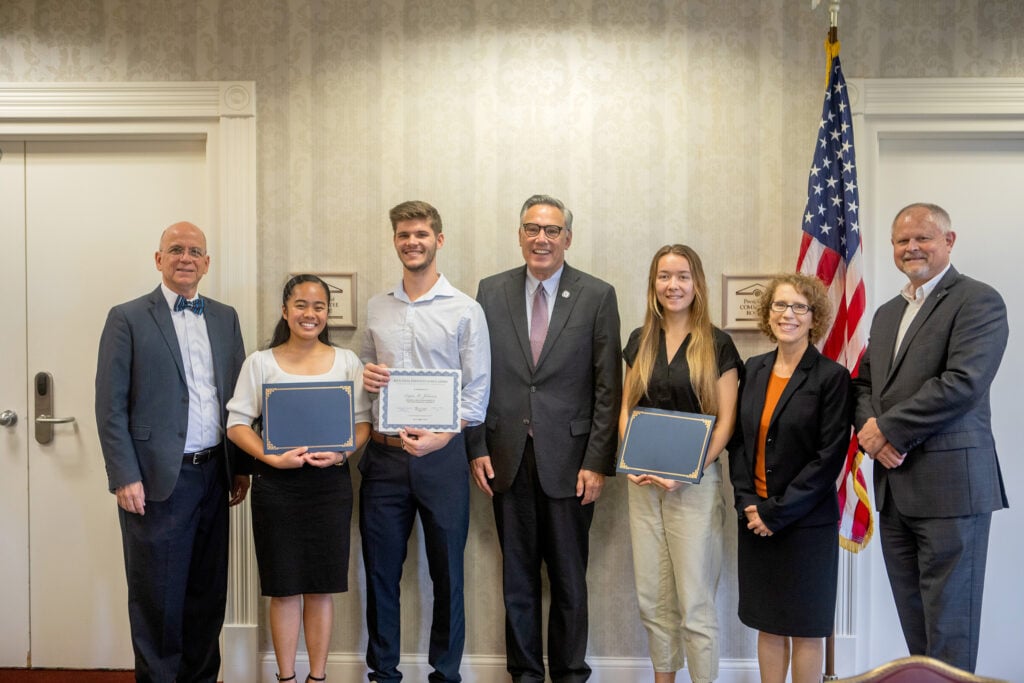A La Sierra University professor’s research uncovering the impact of a 17th century duchess on England’s nascent scientific discourse is being illuminated through publication, presentation, and a new class for students.
Lora Geriguis, professor of English and associate dean of La Sierra’s College of Arts & Sciences, wrote an article for the journal Pacific Coast Philology on the formation during the 1600s of the Royal Society of London for the Improvement of Natural Knowledge and its interaction with the colorful Margaret Cavendish, Duchess of Newcastle-upon-Tyne. Cavendish was a scientist, prolific author, poet, and philosopher ahead of her time.
In a library symposium on women’s lost histories on April 10, Geriguis discussed her findings and Cavendish’s contributions to early discussion of scientific methodology, which the members of the Royal Society mischaracterized.
Geriguis has also published an article on Cavendish’s treatment in literary anthologies, published in English Studies in 2017, and is planning a third article that will critique Cavendish’s portrayal in scientific history generally, and in histories about the Royal Society in particular. Geriguis is also developing a new class that will be taught for the first time in spring quarter 2019 on “Science and Literature,” in which Cavendish’s life and writings will play a part.
Geriguis’ article in Pacific Coast Philology, which was published this past December by the Pennsylvania State University Press, covers the arduous early days of the Royal Society, a research-focused, male-dominated association that evolved over the centuries into one of the foremost scientific organizations in the world.
Titled “Fellows among the Bookshelves: The Royal Society’s Book-gifting Network of the 1660s,” the chapter focuses initially on the formation in 1662 of the Royal Society of London for the Improvement of Natural Knowledge and its members’ efforts to preserve their scientific research in the face of 17th century ridicule by gifting to each other and to libraries their books written about their observations and analysis. They were challenged in their efforts by a public whose education was based on past information handed down through generations and for whom religion, faith and superstition formed the foundation of thought.
“When these ideas about scientific observation and methodology first came up, they were thought of as silly,” Geriguis said. “The fact that men were sitting in a bog watching a butterfly, collecting birds’ nests, collecting weather information, people thought that was crazy.”
The article segues into the society’s interaction with Cavendish and the influence of this inquisitive female aristocrat whose impact on scientific debate has remained largely undervalued. On May 30, 1667, Cavendish, who had written a critique of the society and of its members’ experiments visited the organization, the first woman to do so, and the last for more than 200 years. The society admitted its first female members in 1945 with the election of Marjory Stephenson and Kathleen Lonsdale.
A chartered entity of King Charles II, the Royal Society of London, which was comprised of gentleman scholars, was sponsored in the hopes that it would bring forth revenue-producing inventions by which the king could fill his coffers. The organization’s members paid dues and kept meeting minutes which documented the visit by the Duchess of Newcastle who was portrayed as wonder-struck by the society’s experiments.
Put into the context of Cavendish’s own writings, Geriguis discovered that the society’s depiction of Cavendish’s reaction may not have been forthrightly reflected. While many authors have written about Cavendish, none have questioned the society’s description of her views of their experiments as consisting of utter amazement. “She’s been the subject of hearsay stories passed on. If we take what she actually wrote and put it in context it totally reframes that visit,” Geriguis said.
The Royal Society members engaged in discovery through observation of the natural world, experimentation and use of machinery such as microscopes, telescopes, and air pumps. Their experiments included putting chemicals on meat to show how the meat would disintegrate and placing a flea under a microscope to observe it in enlarged form.
Cavendish, by contrast, thought the microscope distorted the truth rather than enhanced knowledge. For example, she wondered how an enlarged view of a flea helps a beggar covered with fleas. “She believed in the natural eye and the eye of imagination. She was interested in topics of science but didn’t trust instrumentation,” Geriguis said.
Geriguis’ study of Cavendish, her scientific views and her interaction with the Royal Society is drawn from research during sabbaticals in 2011 when she analyzed how the environment was understood during the 17th and 18th centuries, and in 2016 after her curiosity was piqued by descriptions of Cavendish and the Royal Society in a thinly-sourced book written in 1918.
Her sources include a first edition of a Cavendish book published in 1663 and housed at The Huntington Library in San Marino. It was previously owned by Edmund Waller, a poet and original fellow of the Royal Society and bears a hand-written inscription on the flyleaf that mocks the Duchess for her scientific views.
“This is telling us about the history of ideas, and that new ideas can create upheaval,” Geriguis said.
The broader, more accurate window into Cavendish’s life affords a learning opportunity for students. Says Geriguis, “We’re trying to equip the students to think along longer trajectories and think in terms of multiple layers of discourse taking place at any given time. For example, is there an agenda behind the use of satire to shut down debate about new ideas?”




